|
|

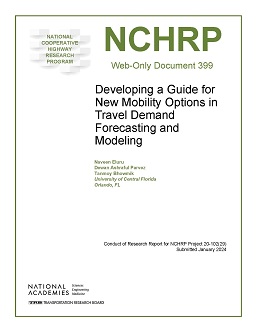 Developing a Guide for New Mobility Options in Travel Demand Forecasting and Modeling
5/27/2024 2:51:48 PM
Developing a Guide for New Mobility Options in Travel Demand Forecasting and Modeling
5/27/2024 2:51:48 PM
The transportation field is undergoing a transformative change in response to several technological innovations resulting in the emergence and widespread adoption of new mobility options (NMOs) such as shared micromobility, transportation networking companies (TNCs), and connected and autonomous vehicles (CAVs). NCHRP Web-Only Document 399: Developing a Guide for New Mobility Options in Travel Demand Forecasting and Modeling , from TRB's National Cooperative Highway Research Program, offers practical gui...
 Response Planning, Assessment, and Rapid Restoration of Service of Bridges in Extreme Events: Background and Summary
5/16/2024 3:00:20 PM
Response Planning, Assessment, and Rapid Restoration of Service of Bridges in Extreme Events: Background and Summary
5/16/2024 3:00:20 PM
Extreme events, such as hurricanes, tornados, floods, earthquakes, fires, and collisions, pose a threat to the transportation infrastructure that millions of people depend on daily. NCHRP Web-Only Document 390: Response Planning, Assessment, and Rapid Restoration of Service of Bridges in Extreme Events: Background and Summary , from TRB's National Cooperative Highway Research Program, supplements the information and guidance on all aspects of response planning, assessment, and rapid restoration of ...
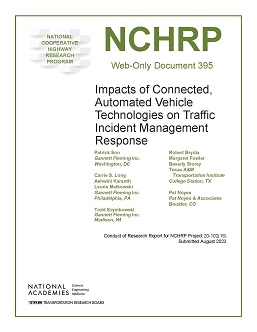 Impacts of Connected, Automated Vehicle Technologies on Traffic Incident Management Response
3/15/2024 7:00:45 PM
Impacts of Connected, Automated Vehicle Technologies on Traffic Incident Management Response
3/15/2024 7:00:45 PM
Traffic Incident Management (TIM) is the process to detect, respond to, and clear traffic incidents so that traffic flow may be restored as safely and quickly as possible. Traffic incidents are unplanned events, such as crashes, that impact traffic flow, and TIM refers to the coordinated process to respond to and clear the incidents. NCHRP Web-Only Document 395: Impacts of Connected, Automated Vehicle Technologies on Traffic Incident Management Response , from TRB's National Cooperative Highway Research ...
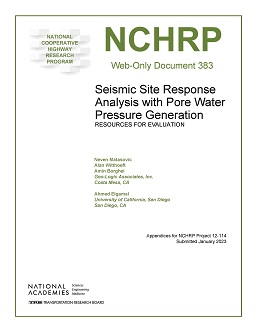 Seismic Site Response Analysis with Pore Water Pressure Generation: Resources for Evaluation
2/16/2024 8:00:41 PM
Seismic Site Response Analysis with Pore Water Pressure Generation: Resources for Evaluation
2/16/2024 8:00:41 PM
There are many seismic site response analysis programs that operate in either the time domain or the frequency domain. These programs are available as public domain software, as commercial products, and/or through direct contact with the authors. NCHRP Web-Only Document 383: Seismic Site Response Analysis with Pore Water Pressure Generation: Resources for Evaluation , from TRB's National Cooperative Highway Research Program, is supplemental to NCHRP Research Report 1092: Seismic Site Response Analysis wi...
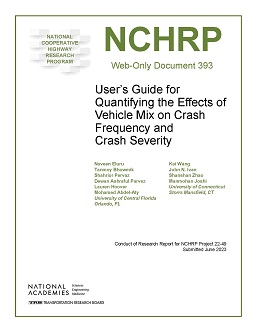 User’s Guide for Quantifying the Effects of Vehicle Mix on Crash Frequency and Crash Severity
2/13/2024 5:06:25 PM
User’s Guide for Quantifying the Effects of Vehicle Mix on Crash Frequency and Crash Severity
2/13/2024 5:06:25 PM
Heavy vehicle traffic and vehicle mix have a substantial impact on crash frequency and severity. The consideration of vehicle mix would improve predictive methods for crash frequency and severity. Improved methods will result in better use of the limited funds and resources available for improving the safety of the highway system and supporting performance-based approaches. NCHRP Web-Only Document 393: User’s Guide for Quantifying the Effects of Vehicle Mix on Crash Frequency and Crash Severity , from TR...
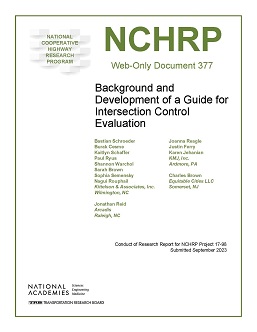 Background and Development of a Guide for Intersection Control Evaluation
2/8/2024 3:00:55 PM
Background and Development of a Guide for Intersection Control Evaluation
2/8/2024 3:00:55 PM
A variety of intersection control evaluation processes and metrics are used by highway agencies for evaluating intersection geometry and control options and identifying an optimal geometric and control solution for an intersection. These processes usually address safety, operational, multimodal, environmental, right-of-way, and cost impacts and other considerations. NCHRP Web-Only Document 377: Background and Development of a Guide for Intersection Control Evaluation , from TRB's National Cooperative Hig...
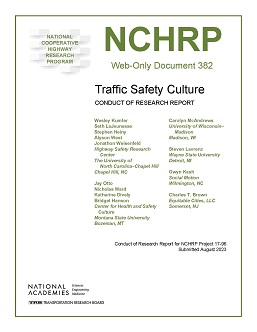 Traffic Safety Culture: Conduct of Research Report
2/5/2024 2:00:29 PM
Traffic Safety Culture: Conduct of Research Report
2/5/2024 2:00:29 PM
Traffic safety culture is a complex topic spanning a range of sociological and philosophical concepts as they relate to transportation safety and the systemic framework that produces different kinds of traffic safety-related outcomes. NCHRP Web-Only Document 382: Traffic Safety Culture: Conduct of Research Report , from TRB's National Cooperative Highway Research Program, contributes to the body of research on traffic safety culture and is designed to help build a practical trajectory for conducting rese...
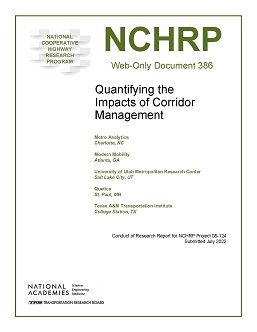 Quantifying the Impacts of Corridor Management
1/26/2024 3:00:04 PM
Quantifying the Impacts of Corridor Management
1/26/2024 3:00:04 PM
Transportation corridors are defined by the infrastructure, services, and relationships connecting places. A corridor can be a national resource connecting large cities, a regional passage connecting a state’s trade centers, or local pathways connecting through a city or town. NCHRP Web-Only Document 386: Quantifying the Impacts of Corridor Management , from TRB's National Cooperative Highway Research Program, details how specific corridor management efforts should be defined and approached, what it mean...
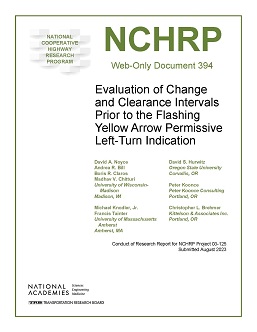 Evaluation of Change and Clearance Intervals Prior to the Flashing Yellow Arrow Permissive Left-Turn Indication
1/19/2024 7:00:33 PM
Evaluation of Change and Clearance Intervals Prior to the Flashing Yellow Arrow Permissive Left-Turn Indication
1/19/2024 7:00:33 PM
When a separate lane is provided for left-turning vehicles, the interval during which drivers turn can be described as either protected or permissive. In a protected left-turn movement, the left-turning driver has the exclusive right-of-way and faces no other (legal) conflicts. In a permissive left-turn movement, the left-turning driver may turn only after yielding to other conflicting movements, including vehicles, pedestrians, and/or bicycles. NCHRP Web-Only Document 394: Evaluation of Change and Clear...
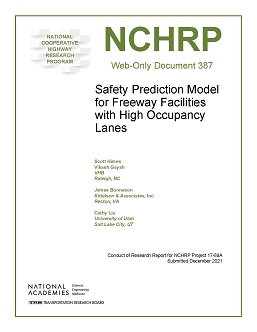 Safety Prediction Model for Freeway Facilities with High Occupancy Lanes
12/27/2023 12:00:58 PM
Safety Prediction Model for Freeway Facilities with High Occupancy Lanes
12/27/2023 12:00:58 PM
In an effort to relieve highway congestion and promote the movement of people, some state departments of transportation have modified their freeway facilities to include high occupancy vehicle lanes, high occupancy toll lanes (HOT, or HO lanes), and other managed lane strategies. NCHRP Web-Only Document 387: Safety Prediction Model for Freeway Facilities with High Occupancy Lanes , from TRB's National Cooperative Highway Research Program, fulfills an analytical gap, providing a safety prediction methodol...
|
|
|